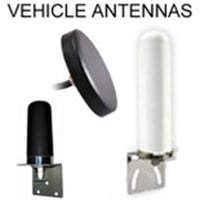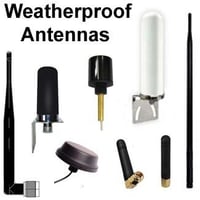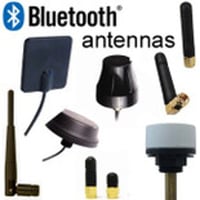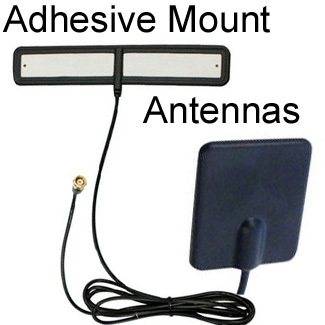WeatherProof & Marine Antennas (low-cost)
Weatherproof Antennas: Waterproof, Marine
Low-Cost Plastic vs Stainless Steel Fiberglass
There are many applications in which waterproof plastic antennas serve very well as a low cost option: Home and small business WiFi and LTE, Bluetooth, Internet of Things (IOT), and many more applications.
Antennas made from fiberglass and stainless steel are typically double the price of plastic waterproof antennas of the same gain and VSWR, but they are a lot more durable. The higher-end fiberglass and steel waterproof / weatherproof antennas, being resistant to rust and corrosion, along with their strength, durability and flexibility, make them ideal for long length rod antennas mounted vertically. They are commonly used in marine applications.
Fiberglass Antennas: The antenna wire is wound inside a fiberglass rod to protect it from corrosion. Unlike pure metal fiberglass is not corroded by sea water, making it suitable for marine applications. Fiberglass is a material made of thermal set plastic reinforced with woven glass fibers. Fiberglass has a high tensile strength, with good chemical and heat resistant properties ideal for weatherproofing electrical equipment. In addition, fiberglass has a low dielectric constant, and low moisture gain.
Stainless steel is used to make parts of fiberglass antennas rust resistant, and to make the mounts for marine antennas resistant to rust and sea water corrosion.
Stainless steel is a corrosion resistant alloy of steel doped with 10% Nickel and at least 18% Chromium. The Chromium forms a thin invisible layer of complex chromium oxide when exposed to air on the surface of the alloy. This layer prevents any further oxidation and any corrosion. Chromium is responsible for the stainless steel’s luster and rust resistance. The Nickel adds strength to the alloy.
What are weatherproof antennas?
Weatherproof antennas are a type of performance antenna that is specifically designed for long-term outdoor installation. The materials and fabrication of a weatherproof antenna can withstand prolonged exposure to harsh outdoor conditions, meaning the lifespan of the antenna is prolonged in comparison to an equivalent antenna that is not weatherproofed.
Weatherproof antennas are extremely varied in their types and specification, due to the broad range of applications and outdoor settings in which they are used. Their resilience against outdoor conditions is primarily due to the antenna being sealed against the ingress of dust and moisture as well as robust and UV-resistant materials being used for the antenna radome.
Outdoor antennas may be individually wall-mounted or pole mounted. They can be directly connected to a radio device that is also installed outdoors or be connected using an antenna cable to a router or access point that is installed inside a property. Other weatherproof antennas are needed for quick connection to handheld and portable devices used by both amateur radio enthusiasts and professional in the emergency services.
RoHS weatherproof antennas
Our expansive selection of high-quality weatherproof antennas is built with the highest standards of manufacturing, using materials with an excellent safety profile and provenance. We ensure that every antenna complies with the relevant national and international electronics legislation which includes:
- The directive on the restriction of the use of certain hazardous substances in electrical and electronic equipment, also known as RoHS. This EU law limits the use of certain hazardous substances in electronics.
- Section 1502 of the Dodd-Frank Act is US domestic legislation that prohibits the use of the precious metals Tungsten, Tantalum, Tin, and Gold (3TG), that has been acquired in conflict zones and using forced labor, in the manufacture of electronics
- The Conflict Minerals Regulation (2021) also deals with the requirement for 3TG metals and minerals to be acquired for electronics from sources that are not using forced labor and funding conflict.
How are antennas weatherproofed?
Antennas that are built or outdoor installation use hard-wearing plastics and metals in their structure. The materials used have to be fatigue-resistant and able to withstand exposure to sunlight, wind, rain, ice, and snow, as well as insects and potentially even bird strikes.
Key materials used in weatherproof antennas include:
- Fiberglass is an exceptionally resilient material that is widely used in outdoor and marine antennas. It is rigid and does not deform which makes it able to provide significant structural support to antennas. It performs well in a wide range of weather conditions and does not crack as the antenna ages. Fiberglass reinforced plastic is also lightweight with excellent wave penetration. Fiberglass radomes are thought to exceed plastic radomes in longevity by between 3 and 5 years, with UV stability and corrosion resistance.
- Plastics such as polypropylene, polycarbonate, and ABS are cost-effective but durable materials for antenna radomes, especially when compared to fiberglass. Radio frequency signals can freely pass through these plastics. These thermoplastics have high rigidity, remain stable over a wide temperature range, and can withstand impacts. They can also have UV-stabilizers and flame retardants added for additional protection of the antenna.
- Polyurethane foam may be used as a mechanical and electrical insulator for the antenna elements within a radome. This is a closed-cell hydrophobic foam that is injected into space within an antenna radome and expands to deliver additional inner protection. PU foam also allows signals to pass through it with little or no absorption.
- Stainless steel is often used in weatherproof antennas because of its notable corrosion resistance. This low carbon steel resists corrosion because of the addition of chromium which produces a protective chromium oxide film on the surface of the metal. This increases its price, but stainless steel delivers great value because of its longevity.
The metals that are used within the antennas conducting element are usually copper or brass. Compared to copper, brass is less likely to become oxidized over time, but copper can be plated with inert metals like silver to prevent corrosion. Antenna connectors similarly are made from plated brass or stainless steel to improve their longevity. The addition of silicone rubber gaskets to the connects provides an additional seal against moisture and dirt.
Weatherproof antennas carry ingress protection ratings
Ingress Protection (IP) Codes provide a helpful indication of the level of protection you should expect from the antenna from physical intrusion, dust, and liquids. This rating system is derived from standards developed by the International Electrotechnical Commission. It assigns a numerical value to express the degrees of protection against dust and liquids respectively. By assessing the IP ratings you can select an antenna that is fully waterproof and dustproof. Here are the key IP codes for weatherproof antennas:
- IP57 weatherproof antennas: Weatherproof antennas that carry this rating are not completely dust-tight but will withstand the entry of dust. They can prevent the entry of damaging moisture after immersion at up to a depth of 1 meter for no more than 30 minutes.
- IP67 weatherproof antennas: are fully dust-tight and will withstand moisture ingress if immersed in up to a 1-meter depth of water for no more than 30 minutes.
- IP68 weatherproof antennas: are dust-tight and water-tight antennas that can withstand being immersed in more than 1 meter of water for longer than 30 minutes.
Types of Weatherproof Antennas
Weatherproof antennas are diverse and the extensive range available makes it easy to find the model that fits your requirements precisely. Omnidirectional weatherproof antennas provide 360-degree coverage around the vertical axis of the antenna, whereas directional weatherproof antennas, focus the radio frequency energy for higher gain, point-to-point connectivity. Weatherproof antennas operate across a range of frequencies and dual-band weatherproof antennas and multi-band weatherproof antennas are also available.
(1) Weatherproof monopole antennas are simple designs that consist of a single wire or rod that is mounted on a ground plane, with a feedline connected to it. The rod is an open resonator and has a length that is proportional to the wavelength of its target frequency. These omnidirectional antennas usually have a magnetic or adhesive mount, meaning that they can be readily mounted to vehicles or other outdoor surfaces.
(2) Weatherproof dipole antennas consist of two antenna elements or wires of equal length that are divided by a feedline. They may be half or quarter-wavelength and are typically housed within a plastic radome or casing. These are monopole antennas and come in a variety of designs including weatherproof stubby antennas and weather-resistant rubber ducky antennas which are small and easy to install on portable or handheld devices.
(3) Weatherproof articulating antennas are often found on routers and wireless access points. These dipole antennas feature articulating connectors with a mechanical knuckle that enables the antenna to be angled through 45 or 90 degrees. The knuckle is a mechanically and environmentally vulnerable component compared to non-articulating dipole designs, but it facilitates more precise positioning of the antenna.
(4) Weatherproof puck antennas are chunky, disc-shaped antennas that closely resemble a hockey puck. This rugged design features a hardwearing plastic or rubberized radome that houses single or multiple antenna elements for multi-frequency coverage. They are easily through-hole mounted and provide omnidirectional coverage. The design is typically fully waterproof and when properly mounted resists vandalization.
(5) Weatherproof collinear antennas are made up of multiple antenna elements (often dipoles) arranged in a vertical array. By combining the elements the overall gain of the antenna is increased in proportion to its vertical height. The antenna is securely housed in a fiberglass cylindrical radome that protects them from the weather and provides structural support. Collinear antennas are designed to be mounted at height and provide omnidirectional coverage.
(6) Weatherproof panel antennasare performance directional antennas that can be mounted on walls for low-profile flat appearances. The antenna consists of a dipole element that is covered by a flat radome.
Why are weatherproof antennas important?
Weathering can rapidly destroy antennas that are not designed for sustained exposure to the outdoor environment. In marine settings, the lifespan of an antenna can be as little as a few weeks. The combination of sun, windblown dust, high humidity, rain, snow, and ice has the effect of wearing down the antenna materials and inducing corrosion which progressively breaks down the metal components in the antenna, rendering it useless.
Quality weatherproof antennas slow the progression of corrosion
Corrosion is a process by which metals and other materials chemically react with substances in their environment and become degraded. It is a continual and inevitable outcome of their exposure. Several environmental factors drive the corrosion process and are mitigated by using a well-sealed weatherproof antenna. These include:
- Moisture is a key driver of corrosion as the hydrogen and oxygen in the water will react with the metal surface. Humidity and condensation that gets into the antenna will cause focal corrosion which will eventually spread through the structure.
- Salts that are in the coastal air, air pollution, or dust alight on metal surfaces, and the ions in them will react with metal surface electrons leading to the breakdown of the metals. “Salt-creep” accelerates the spreading of corrosion along metal surfaces.
- Dust is composed of organic and inorganic particulates that will settle and build-up on any surface they can alight on. Dust acts like a humectant, drawing moisture from the air and becoming a focus for corrosion. Windblown dust becomes trapped in the seams of antenna radomes and the threading of connectors making them less effective barriers to moisture and impairing the electrical performance of the antenna.
- Sunlight not only heats the antenna but its UV portion will attack the antenna housing via the process of photodegradation. The UV light weakens chemical bonds in plastics leading to a gradual breakdown of these materials that can become cracked and allow moisture to enter the antenna interior.
Weatherproof antennas are designed to withstand these factors that cause corrosion, and though no waterproof antenna will remain corrosion-free, the purchase of a weather-resistant antennawill prolong the lifespan of the antenna.
Key Applications of Weatherproof Antennas
Outdoor antenna installations are necessary for a wide range of wireless networking, radio, and satellite communication technologies. The selection of a weatherproof antenna safeguards the performance of the network and keeps downtime to a minimum. These are some of the key wireless technologies that use weatherproof antennas.
[A] Weatherproof Cellular Antennas
These cellular antennas are an effective solution for improving cellular network coverage on your property. Weatherproof cellular antennas can be installed outdoors and connected to a cellular booster to enhance poor signal if your property is distant from the local cell tower. Weatherproof antennas are available for the following technologies and their related frequencies:
- The Global System for Mobile Communications (GSM) is a European-developed second generation (2G) cellular communications technology. It was one of the first cellular networking technologies to make the transition from analog to digital switching and is known for its use of a Subscriber Identity Module (SIM) card. Though it has been shut down by US networks such as AT&T, GSM is still in widespread use throughout much of the globe. Initially, GSM provided full-duplex voice telephony, but later enhancements to the networks support the transfer of data packets using either Enhanced Data Rates for GSM Evolution (EDGE) or the General Packet Radio Service (GPRS). Weatherproof GSM antennas need to be selected according to the territory, frequency, and network they will be used for; there is not a single GSM antenna. Because of the expansive global coverage, GSM networks use a broad range of frequencies including:
- GSM 450 (450 MHz)
- GSM 750 (750 MHz)
- GSM 850 (850 MHz)
- GSM 900 (900 MHz)
- 1800 MHz
- 1900 MHz
Third Generation (3G) cellular networks are based on the Universal Mobile Telecommunications System (UMTS) standards developed by the Third Generation Partnership Project (3GPP). This cellular technology builds on the EDGE and GPRS technologies, to deliver increased data transfer speeds, throughput, and network capacity. Later iterations of the 3G standard also support the provision of mobile broadband internet connectivity. This is achieved by using a different type of cellular networking known as Wideband - Code Division Multiple Access (W-CDMA) that facilitates transmissions of several devices simultaneously over a single communication channel. Key frequencies used by 3G (UMTS) weatherproof antennas, vary by geographic territory and include:
- 700 MHz
- 800 MHz
- 850 MHz
- 900 MHZ
- 1900 MHz
- 2100 MHz
Long Term Evolution (LTE) / Fourth Generation (4G) networks deliver broadband cellular coverage which includes voice telephony, VoIP telephony, mobile broadband internet, HD mobile TV, and video calling. 4G is a development of the LTE standards that first made these more expansive services available and feature a huge uplift in data rates to as much as 1 Gigabit per second for low mobility communication. 4G networking was first introduced in 2011 and is now a globally implemented standard for cellular communication. Weatherproof 4G/LTE antennas support the full complement of 4G services and connectivity across the range of frequencies used by this technology. Select the 4G/LTE outdoor antenn a that matches the frequency used in your region. These include:
- 700 MHz
- 800 MHz
- 850 MHz
- 900 MHz
- 1700 MHz
- 1800 MHz
- 1900 MHz
- 2100 MHz
[B] GPS Weatherproof Antennas
GPS weatherproof antennas are critical to good Global Positioning System (GPS) connectivity as GPS antennas need exposure to the open sky and perform extremely poorly indoors. GPS is the leading satellite-based radio navigation system and harnesses data transmissions from a constellation of 24 orbiting satellites launched and managed by the United States Space Force. The satellites occupy Medium Earth Orbit (MEO) planes, have an onboard atomic clock, and transmit a carrier signal that includes data that identification, time, and positional data that can be used by a GPS receiver on earth for time, tracking, and geolocation purposes.
The GPS signal received by outdoor GPS antennas is available at three key frequencies :
- L1 (1575.42 MHz)
- L2 (1227.60 MHz)
- L5 (1176.45 MHz)
By the time the GPS signal has penetrated the earth’s ionosphere, it has been massively attenuated, meaning that GPS antennas need to be extremely sensitive to obtain a fix quickly. By using a weatherproof antenna the performance of the antenna is safeguarded for the optimal performance of GPS handsets and other devices.
[C] Weatherproof WiFi Antennas
The Institute of Electrical and Electronics Engineers (IEEE) 802.11 protocol was developed by the WiFi Alliance to provide a wireless local area network capable of delivering internet connectivity to a wide range of environments, including outdoors. Weatherproof WiFi antennas are available to provide both omnidirectional and directional WiFi connectivity outside, using the six variants of the 802.11 standard that are in widespread use. Multiple articulating weatherproof antennas can be used with MIMO WiFi routers and access points by screwing them into the router’s outlets via the antenna connector. Outdoor WiFi antennas operate at the following frequencies:
- 2.4 GHz is the original frequency band used for WiFi and is known for having good penetration and coverage. Other wireless networks also use this frequency which can make WiFi prone to interference.
- 5 GHz delivers higher speeds and is less vulnerable to interference due to the volume of bandwidth available in this frequency band. It is more easily attenuated and so provides more limited coverage when compared to 2.4 GHz.
[D] Waterproof Bluetooth Antennas
Bluetooth is a leading wireless technology that is used for Personal Area Networks (PANs). It is widely used for consumer devices such as phones, headphones, laptops, and speakers. Bluetooth antennas also use the 2.4 GHz, frequency band.
[E] Waterproof RFID Antennas
Radio Frequency Identification (RFID) is an emerging technology associated with the identification and tracking of objects and related to the Internet of Things. Objects are marked with active (powered) or passive RFID tags which can transmit identification and other data about themselves when interrogated by an RFID reader. RFID solutions have a range of applications including inventory, stock control, warehousing, and logistics, which may require the installation of RFID antennas in outdoor settings. The antennas used may be low frequency, high frequency, ultra-high frequency, or microwave.
Frequently asked questions
How does a cellular booster or repeater work?
Cellular repeaters are a solution for improving cellular network coverage in remote areas. They are a bi-directional amplification system that consists of:
- An outdoor donor antenna
- A signal amplifier
- An indoor antenna that rebroadcasts the cellular signal
The components are connected using coaxial cables. The outdoor cellular antenna is critical for acquiring a cellular signal that may be distant or particularly weak. It should be installed at height on the outside of the building it serves. It may be omnidirectional or directional, but well-positioned weatherproof directional antennas provide the best opportunity to acquire a distant cellular signal with a favorable signal to noise ratio (SNR).
The signal acquired by the donor antenna is transmitted via coaxial cable to a signal amplifier, that is capable of generating an output power of 8 to 10 Watts. The amplifier must be well isolated from both the donor and rebroadcasting antenna to prevent amplification of interference. The amplified signal is then delivered to the indoor space via the rebroadcasting antenna.
What is the best position for mounting a weatherproof antenna outdoors?
Here are some quick pointers for positioning a weatherproof antenna outside:
- Position for an optimal line of sight. As much as possible, the weatherproof antenna should be pointed in the direction of the target antenna or base station. An unobstructed view provides the best opportunity for line of sight propagation as the radio frequency signals will travel directly to the receiving antenna.
- Mount at height. Height is advantageous for the performance of an antenna as there are fewer obstructions that can reflect or attenuate the signal.
- Avoid vegetation. Trees and bushes can absorb radio frequency signals that mad through or near them. If vegetation is in the sightline of the antenna its height should be increased to be clear of the obstruction.
- Avoid bodies of water. Lakes, ponds, and swimming pools are a source of signal reflections and multipath interference. Again, mount the antenna at height if water cannot be avoided.
- Avoid physical obstructions. Hills, buildings, and other obstructions will impede or block signals. If greater height can not be reasonably achieved for mounting the antenna an alternative position will need to be sought.
What weatherproofing accessories are available to be used with these outdoor antennas?
The use of weatherproofing accessories can help you further enhance the performance and longevity of antennas and other outdoor wireless equipment.
Key weatherproofing accessories include:
- Enclosures are hard-wearing, weatherproof cabinets that can be used to seal antennas, routers, and other electronic components from the effects of dust, dirt, moisture, and solar radiation. Like weatherproof antennas, they typically carry IP ratings for the level of protection they provide. Plastic enclosures are fully permeable to radio frequency signals and can be used to house antennas without compromising their performance.
- Coax seal tape is a sticky mastic tape that provides an excellent seal for coaxial connectors and antenna cables. It is stretch-wrapped around connectors and molded to create a water and weatherproof seal. The tape can be cut away when the connector needs to be accessed.
- Cable glands and couplings also provide rated protection for antenna cables and connectors. These sealed conduits can be attached to enclosures or NEMA boxes or used to house and seal connectors within the body of the weatherproof coupling.
In conclusion
Weatherproof antennas are essential for outdoor wireless networking infrastructure that performs properly and has an acceptable lifespan. Choose from amongst this extensive selection of IP rated outdoor antennas the type and frequency needed for your installation.
LEARN MORE:
- Marine antennas
- Waterproofing and weatherproofing equipment for antennas
- Antenna cables and connectors
- Antenna mounts







